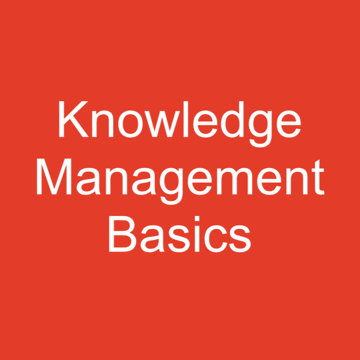-
Posts
634 -
Joined
-
Last visited
-
Days Won
42
Content Type
Profiles
Forums
Downloads
Events
Store
Posts posted by Tom Spencer
-
-
Template - Creating a Problem Statement
View File
Here is a template that you can use to gather relevant information in order to develop a robust problem statement.
A problem statement is a statement that describes the goals of the client project clearly and concisely. A clear problem statement makes it easier to establish clear boundaries for the project in order to prevent scope creep, ensures that you focus resources and efforts in the right direction, and makes it easier to regularly check back to make sure you are fully addressing the agreed problem. Most often clients come to consultants with problems that aren’t well defined. As a consultant, you must make sure that you translate a general problem into a client problem statement.
-
Submitter
-
Submitted04/19/2023
-
Category
-
-
Consulting Unleashed - A Practical Guide for University Students
View File
In this guidebook, we'll dive into the intricacies of the consulting industry. We’ll look at how to prepare for a consulting career, including the recruitment process, how to prepare for consulting interviews, and the frameworks you'll need to master to succeed as a consultant. We'll cover critical topics for navigating the industry, such as onboarding, maintaining work-life balance, and pursuing a successful career path. We’ll also uncover how to excel in this field, including developing business acumen, managing clients, leading project teams, building a professional network, and driving organisational change.
-
Submitter
-
Submitted03/26/2023
-
Category
-
-
Budget Planner - Money Smart
This is an excel file which contains a basic budget planner developed by The Australian Securities & Investments Commission.
-
Submitter
-
Submitted05/19/2021
-
Category
-
-
Brief Guide to Digital Currency
This guidebook explores the nature, value, and potential risks of digital currency.
-
Submitter
-
Submitted10/29/2020
-
Category
-
-
Brief Guide to Marketing Mix Modelling
Marketing Mix Modelling can be used to help businesses measure the effect of advertising, packaging, distribution channels, media expenditures, social media, and sales organizational structure on brand share or sales.
This brief guide answers a four key questions:
- Why use scientific methods in marketing?
- What is marketing mix modelling?
- Who should do the modelling work?
- What is essential for successful marketing mix modelling?
The guide was prepared by Jason Oh, a Senior Consultant, Strategy & Customer at EY with project experiences in commercial due diligence and corporate strategy planning. Previously, he was a Management Consultant at Novantas with a focus on the financial services sector, where he advised on pricing, marketing, channel distribution, digital transformation and due diligence.
-
Submitter
-
Submitted09/05/2020
-
Category
-
Brief Guide to Customer Segmentation
This brief guide to customer segmentation by Jason Oh contains information about:
- The definition of customer segmentation
- Why customer segmentation is important
- The four common types of customer segmentation
- Three analytical methods for performing customer segmentation
- Tools you can use
-
Submitter
-
Submitted06/23/2020
-
Category
-
Savings and Spending in the Economy
Many mainstream economists argue that while individuals can save, an economy taken as a whole cannot because one person's spending is another person's income.
This line of reasoning seems to defy logic and begs two questions:
- Can economies accumulate savings?
- Can total spending in an economy exceed total income?
This PowerPoint deck shows the traditional model which suggests that an economy cannot accumulate savings and total spending will equal total income. It then proposes a simple revised model which suggests that (a) an economy can accumulate savings and (b) total spending can exceed total income.
If you have studied economics, the slides will take 5 minutes to read through. Although you may have to brush up on how the banking system creates credit since this topic is typically absent from economics courses. Please take a look, and send your constructive criticism to tom [at] spencertom [dot] com
-
Submitter
-
Submitted04/29/2020
-
Category
-
Brief Guide to Statistics
This Brief Guide to Statistics was designed to help busy young professionals understand basic statistical concepts and be able to apply them to business scenarios. It contains four main sections:
- Statistical inference
- Hypothesis testing
- Covariance and correlation
- Regression modelling
The guide was prepared by Jason Oh, a management consultant at Novantas with expertise in scaling profitability for retail banks (consumer / commercial finance) and diversified financial service firms (credit card / asset management / direct bank).
-
Submitter
-
Submitted06/17/2019
-
Category
-
Brief Guide to Asset Management
This Brief Guide to Asset Management was designed to help students and young professionals better understand asset management. It contains four sections:
- Industry overview
- Valuation of asset management firms
- Client segmentation
- Recent trends
The guide was prepared by Jason Oh, a management consultant at Novantas with expertise in scaling profitability for retail banks (consumer / commercial finance) and diversified financial service firms (credit card / asset management / direct bank).
-
Submitter
-
Submitted06/02/2019
-
Category
-
Mounir,
If you want people to respond, it might be helpful to let people know some more details about who you are and what you're looking for in a consulting firm. For example:
- Location(s)
- Service/functional areas
- Size of the firms you're considering
- How you can add value as an owner/investor
-
Hey Vanderbilt Senior,
In my experience, staying semi-fit requires a moderate time commitment of 30 minutes per day (the hard part is staying consistent). I personally recommend this plan for physical fitness called 5BX (or XBX for women): https://www.spencertom.com/hub/files/file/94-plan-for-physical-fitness/
That being said, I know lots of people like going to the gym, it's more social, and getting a personal trainer is an easy way to stay on track. You would need to look into it but an "Uber for personal trainers" seems on its face like it wouldn't be a very scaleable business model. Although, it may get traction in major metro areas and be more viable once we have autonomous vehicles since the cost of delivering the personal trainer to specific locations will fall dramatically.
In the mean time, it may be worth asking yourself "what value does a personal trainer provide to people in the gym?" Motivation and knowledge are two big things. These might best be provided through an app. For example, take a look at these fitness apps.
-
-
Networking Contact List
View File
This excel spreadsheet was prepared by Jason Oh, President of the Consulting Club at Wilfrid Laurier University in 2018.
It provides a template for organising your networking contact list in order to network efficiently during the consulting application process.
To stay in the loop by following us on LinkedIn, please click here.
-
Submitter
-
Submitted04/21/2018
-
Category
-
-
Knowledge Management Basics
Produced by Aneta Kosinska, this document provides you with the basics on knowledge management including:
- Expert views,
- The definition,
- Key challenges, and
- Ways to encourage knowledge sharing.
-
Submitter
-
Submitted04/06/2018
-
Category
-
Template Case Notes
Prepared by Vishal Agarwal, EY consultant and MBA candidate at Kelley School of Business, this is a sample document that shows how to use a plain A4 sheet to take notes during the case interview.
-
Submitter
-
Submitted03/16/2018
-
Category
-
-
Hi Chen,
Thanks for this post!
So, I understand your basic questions to be: are psychopathic traits and consulting success positively correlated?
Two sub-questions might be:
- what traits do we consider to be "psychopathic"?
- what do we mean by "consulting success"?
Here are some initial thoughts. I hope others with more knowledge can correct or expand on these ideas.
Psychopathic traits
My impression is that "psychopathy" is an extreme form of what psychiatrists call anti-social personality disorder.
Hervey Cleckley, who was an American psychiatrist and pioneer in the field of psychopathy, seems to have suggested psychopathy entails three main traits:
- Boldness. This trait would include high stress-tolerance, toleration of uncertainty, as well as high self-confidence and social assertiveness.
- Disinhibition. This trait would include impulsive behaviour, and problems with planning and foresight.
- Meanness. This trait would include lack of empathy for others, and defiance of authority.
Consulting Success
"Consulting success" we might broadly define as consistently satisfying supervisors and clients so that you get promoted towards partner level, and offered repeat business by clients.
Is there a correlation?
The Vault article you linked to suggested that corporate psychopaths tend to get promoted more often than their peers. If that's accurate, would the same correlation be likely to hold in consulting?
Well, looking at the three psychopathic traits identified above, my uninformed guess would be that trait #1 and #3 positively contribute towards success in consulting.
Consulting projects involve solving problems that are too big, new, unstructured, or time sensitive for the client to deal with internally. Hence tolerance of uncertainty (trait #1) would seem to be useful in this environment. Consulting projects also involve working on a team where you have to present yourself in the best possible light, and make sure you don't get exploited or worked to the bone by your manager or colleagues. Some amount of disagreeableness (trait #3) would therefore seem useful in protecting your own position relative to the group.
Having said that, I doubt that impulsivity (trait #2) is a predictor of consulting success. The consultants I know tend to have a planned, methodical, and structured approach to their work.
I would love to hear other people's ideas on this topic.
-
 1
1
-
Many thanks, Consultant Police!
-
My understanding is that consultants in a consulting firm work on project teams. However, there are a range of internal support roles at consulting firms which I understand are not project based, for example HR, legal, finance, IT, and admin.
Consultants who work for a consulting firm are external consultants. They come to the client to work on a specific project, and then leave after the project comes to an end. Consultants might also work as an employee within a company, in which case they are internal consultants. Internal consultants might work on projects, but may also be involved a range of ongoing responsibilities like strategic planning.
-
Hi PliXos,
Good question. This article may help you: How to Choose the Right IT Outsourcing Provider.
-
Consulting is a skill learnt by doing the work of consulting to clients. I believe universities can teach concepts but are not well placed to teach practice.
In many universities, students have solved this problem by forming consulting clubs that provide free consulting services to charities and local businesses. For example, the Global Consulting Group is a student run consultancy founded at Melbourne and Monash universities.
-
 1
1
-
-
This is a very good question, and I have the same question about law firms.
How can clients ensure that they receive a quality service?
The short answer is that it is often impossible for clients to verify the quality of a professional service e.g. accounting, law, management consulting. That is why large companies typically hire the firms with established well known brand names.
McKinsey, BCG and Bain are the top three management consulting firms, and so large companies can feel confident that these consulting firms will provide a quality service. Consulting firms with a strong reputation will normally not want to risk damaging their reputation by doing a poor job. Bad news travels quickly.
-
 1
1
-
-
Hi Abby,
According to IBIS World, the growth rate of the management consulting industry in China from 2012 to 2017 was around 11% with industry revenue of around $25 billion.
What is your source of information suggesting there is a downturn in consulting in China?
-
It is possible and already starting to happen with sites like Freelancer and PeoplePerHour.
A key question for these platforms, though, is what kind of business model to use?
If the platform aims to make money by charging a fee for every project or hour that the consultant works, then the consultant has an incentive to use the platform initially and then avoid the platform once they have attracted a few paying clients. As a result, the only consultants who will use this kind of platform in the long run are ones who are not competent at attracting and retaining clients on their own merits. Such a platform will ultimately become full of low quality consultants (this seems to be the case with Freelancer).
If the platform aims to make money by charging consultants a subscription fee, then it needs to be able to offer enough value (e.g. a steady stream of potential clients) to make the subscription fee worthwhile. This is similar to the business model used by LinkedIn Premium, which gives its premium users broad powers to search for people in specific locations and industries. However, while LinkedIn Premium may help consultants identify potential clients, it still does not guarantee that they will be able to make a sale.
Platforms are tools that can help people to connect and communicate, and as a result can support consultants in their sales and marketing efforts. However, at the end of the day, generating sales still depends on other important factors like having the right marketing message, having some relevant services/solutions to offer clients, and having a strong reputation within your relevant industry niche.
-
Junior consultants are the ones who do the bulk of the work in top consulting firms. They require strong analytical and quantitative skills, but also require other qualities like communication skills, people skills, leadership and self motivation.
Once a consultant becomes a partner, the key skills she requires are sales and marketing skills. Consulting is a business like any other, and if you don't have the ability to attract paying clients then your analytical skills and other positive qualities won't be very helpful.












Resource - Template - Workplace
in Consulting Forum
Posted
View File
Template - Workplace
Here is a good template, with illustrative inputs, of a well-structured workplan to help you organize and plan the analysis and data required to validate your hypotheses as part of the hypothesis-based problem solving approach.